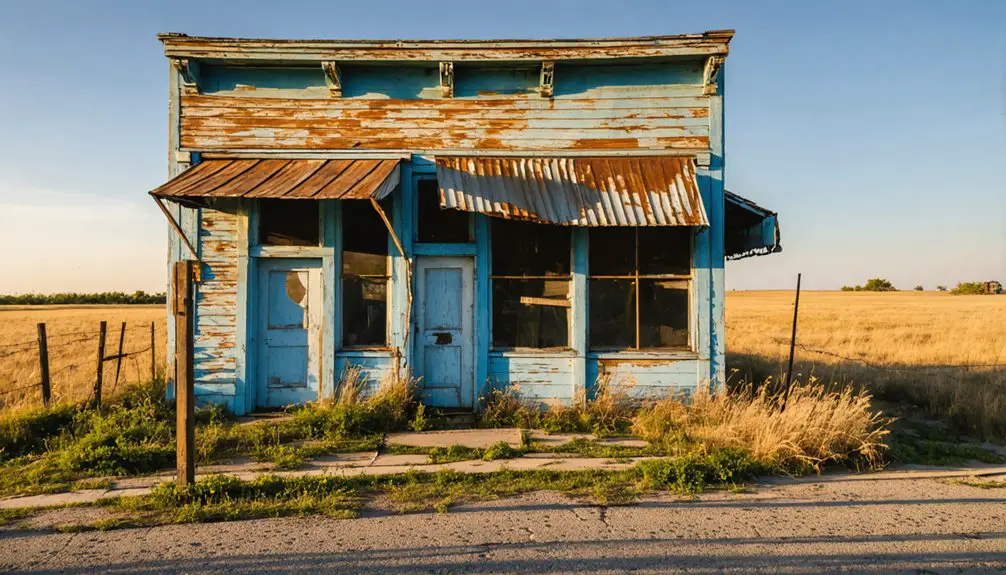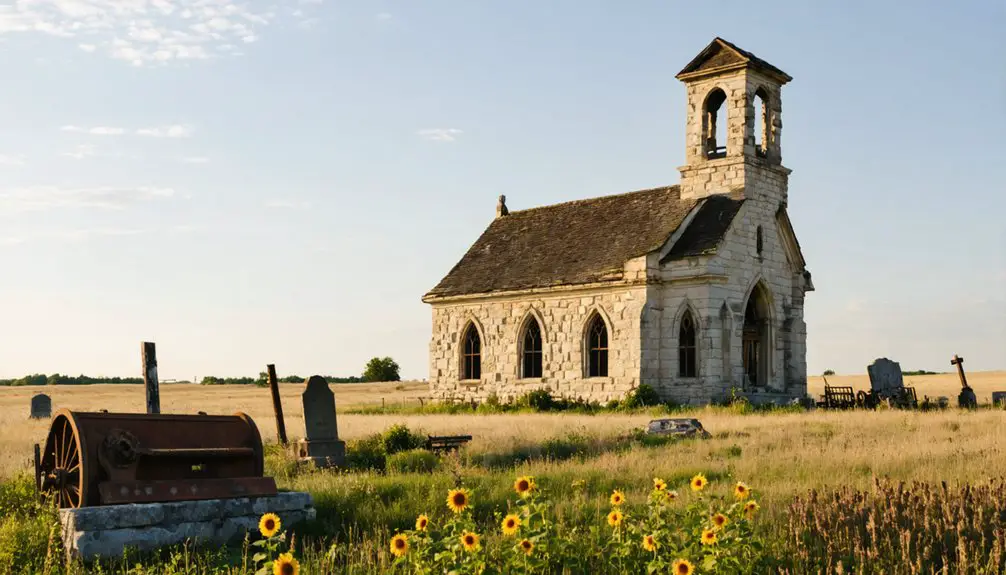You’ll find Bigelow, Kansas beneath the waters of Tuttle Creek Lake today, but in 1881 it emerged as a bustling limestone quarry town. Named after railroad official Alfred Bigelow, the community peaked around 1910 with 200 residents, thriving businesses, and Missouri Pacific Railroad connections. After the quarries closed that same year, the town declined steadily until 1962, when the Tuttle Creek Lake project forced final evacuation. The town’s limestone legacy holds deeper stories of prosperity and loss.
Key Takeaways
- Bigelow, Kansas became a ghost town after the construction of Tuttle Creek Lake in 1962 forced residents to evacuate.
- Founded in 1881 around limestone quarries, Bigelow reached its peak population of 200 residents in 1910.
- The town’s economy centered on limestone quarrying, with the Missouri Pacific Railroad transporting the material for commercial use.
- Only a historical marker at 17th and Zenith Roads and the Antioch Cemetery remain as physical evidence of the town.
- Bigelow’s decline began with quarry closures in 1910 and culminated with the Tuttle Creek Lake project’s forced evacuations.
The Birth of a Limestone Legacy
While many Kansas towns emerged from railroad junctions or agricultural settlements, Bigelow’s story began in 1881 when Jacob Inman discovered valuable limestone deposits on his farmland.
You’ll find that limestone extraction quickly became the driving force behind Bigelow’s establishment, transforming scattered farmland into a bustling quarry town. Like many locations sharing the Bigelow namesake, this settlement carried significant historical importance.
The Central Branch of the Missouri Pacific Railroad recognized the potential of the area’s magnesia limestone, known for its superior quality and versatility. The town was named after General Alfred Bigelow, a prominent railroad official who helped establish the line.
You can trace Bigelow’s community development to Inman’s decision to plat 40 acres of his land, creating space for quarry workers and their families.
The town soon boasted essential infrastructure, including homes and a limestone schoolhouse, all centered around the promising quarry operations that would shape Bigelow’s destiny.
Peak Years and Community Life
During Bigelow’s peak years, you’d find the streets bustling with workers heading to and from the limestone quarries, while Missouri Pacific trains regularly rolled through town to collect their prized cargo.
The railroad’s presence transformed daily commerce, enabling local merchants to stock their shelves with goods from distant cities while facilitating the shipment of superior-grade limestone to markets across the region.
You could witness the town’s importance through its various businesses, including the bank, telegraph office, and multiple stores that served the needs of nearly 200 residents during the community’s height in 1910. In that first year of quarry operations, workers extracted enough stone to fill 600 railroad cars, demonstrating the immense scale of the mining operation.
Daily Life Activities
As Bigelow reached its peak population of 200 residents around 1910, the town bustled with activity centered around its limestone quarry operations and vibrant community spaces.
You’d find daily life revolving around the quarry’s rhythms, where up to 300 men labored to extract and shape limestone.
After work, you could visit local stores for necessities, catch up on news at the telegraph office, or attend communal gatherings at one of two churches.
Local traditions emerged through school functions and religious celebrations, while the newspaper kept you connected to community happenings.
You’d rely on the railroad for transportation to larger markets, and the post office served as your link to the outside world.
The town’s limestone buildings, from homes to the schoolhouse, provided sturdy shelter for your daily activities.
Railroad and Commerce Impact
The Missouri Pacific Railroad transformed Bigelow into a thriving commercial hub after establishing the town in 1881.
You’d find the town’s railroad expansion directly tied to its exceptional limestone quarries, which shipped 600 rail cars of material in their first year alone.
The commerce evolution brought dramatic growth, with employment reaching 300 men in the quarries during peak operations.
The town reached a peak population of about 200 residents during its most prosperous period.
Economic Forces Behind Growth and Decline
Founded in 1881, Bigelow’s economic prosperity hinged primarily on its high-quality limestone quarries operated by Jacob Inman. The Missouri Pacific Railroad’s exclusive purchase of the quarry’s output demonstrated the town’s economic resilience, supporting a population that grew to 200 by 1910.
Through community collaboration, the town developed a diverse commercial infrastructure including a bank, newspaper, and multiple stores.
Bigelow’s strong community spirit fostered growth, establishing vital businesses that served as the heartbeat of this enterprising town.
You’ll find that Bigelow’s decline began with the quarry’s closure in 1910, triggering a chain reaction of economic challenges. Agricultural mechanization led to larger farms needing fewer workers, while nearby cities like Manhattan drew away younger residents seeking better opportunities. Similar to many towns in the Great Plains region, Bigelow’s story reflects a 75-year pattern of population decline as farming technology advanced.
The loss of population weakened the town’s commercial base, ultimately leading to the closure of essential services and its post office by 1960.
The Tuttle Creek Lake Project Impact
While economic forces played a significant role in Bigelow’s decline, construction of Tuttle Creek Lake in 1962 delivered the final blow to this once-thriving community.
The massive flood control project required acquiring nearly 34,000 acres outright and flowage easements on another 27,000 acres, forcing the displacement of residents from ten towns including Bigelow.
You’ll find that many locals resisted the federal government’s plans, fighting the project for 13 years before court orders finally compelled them to evacuate their homes.
Though the dam has prevented over $3 billion in flood damages since completion, the human cost was steep.
Today, sedimentation management challenges plague the reservoir, which has lost 38% of its surface area, while the ghostly remains of Bigelow lie beneath its waters.
The U.S. Army Corps of Engineers is now testing innovative water injection dredging methods to combat the severe sedimentation issues.
The lake now serves as a crucial resource, providing drinking water supplies for more than 40% of Kansas residents.
Preserving Historical Memory

Memory’s endurance takes physical form through dedicated preservation efforts at Bigelow’s former site.
You’ll find a historical marker at 17th and Zenith Roads, along with the Antioch Cemetery, serving as tangible links to the community’s past. Life Magazine’s 1960 photographs captured the town’s final days, while surviving limestone buildings in surrounding areas stand as evidence to Bigelow’s industrial heritage.
The historical narratives live on through descendants’ oral histories, reflecting both the town’s vibrant culture and the trauma of displacement.
Community resilience shows in the ongoing maintenance of memorial sites and the sharing of personal stories. Despite physical demolition, you can explore Bigelow’s legacy through video documentation, interpretive materials, and the limestone structures that still dot the regional landscape.
Lessons From a Lost Prairie Town
Bigelow’s rise and fall offers stark lessons about the precariousness of single-industry towns on America’s frontier.
When the limestone quarries thrived, you’d have found a vibrant community with schools, churches, and businesses. But without economic diversity, the town couldn’t survive the quarry’s closure.
You’ll see how community resilience was tested as Bigelow faced dual challenges: first, the natural decline when its primary industry failed, then the forced evacuation for Tuttle Creek Lake.
The town’s cultural heritage, built on local limestone and frontier spirit, couldn’t withstand these pressures.
Today, only a marker and cemetery remain, reminding you that economic sustainability requires more than one industry.
Bigelow’s story warns modern communities about the risks of putting all their eggs in one basket.
Frequently Asked Questions
What Happened to the Families Who Lived in Bigelow After Demolition?
You’ll find most families faced forced relocation to nearby towns like Frankfort, causing significant community impact as they scattered, sought new employment, and rebuilt their lives while maintaining connections through Antioch Cemetery.
Are There Any Surviving Photographs of the Original Bigelow Townsite?
You’ll find surviving photographs from Life Magazine photographer Thomas D. McCavoy, who documented the townsite history in May 1960, shortly before demolition. Additional images may exist in railroad and state archives.
Did Any Businesses Besides the Limestone Quarry Operate in Bigelow?
With a peak population of 200 residents, you’d find diverse business activities beyond the quarry – including a bank, post office, lumberyard, drugstore, jewelry store, and multiple general stores supporting the local economy.
What Native American Tribes Originally Inhabited the Bigelow Area?
You’ll find the Kanza and Pawnee tribes dominated the tribal history near today’s Bigelow, while Osage and Comanche influenced the native culture through their broader presence in Kansas’ northern territories.
How Did General Alfred Bigelow Contribute to the Town’s Development?
Like a railroad baron of legend, you’ll find General Bigelow’s influence through his town planning and community leadership, as he secured railroad connections that attracted businesses, supported quarry operations, and enabled economic growth.
References
- https://en.wikipedia.org/wiki/Bigelow
- https://lostkansas.ccrsdigitalprojects.com/sites/lostkansas/files/private_static/2022-12/LT_MS_Bigelow_Broxterman.pdf
- https://www.youtube.com/watch?v=iB5rHT14eVI
- https://kids.kiddle.co/Bigelow
- https://www.wikiwand.com/en/articles/Bigelow
- https://legendsofkansas.com/bigelow-kansas/
- https://www.romeoriders.com/forums/viewtopic.php?t=173
- https://www.kancoll.org/books/cutler/marshall/marshall-co-p1.html
- https://www.youtube.com/watch?v=0wTaBKVg3dk
- https://www.youtube.com/watch?v=ie3zwwHm2Jg



